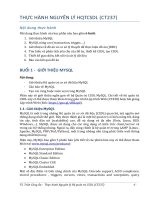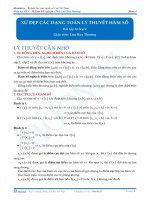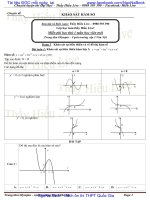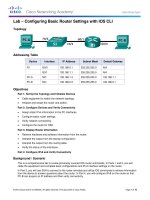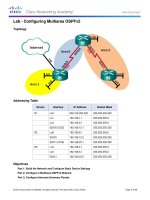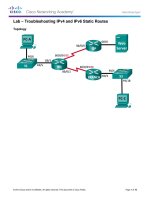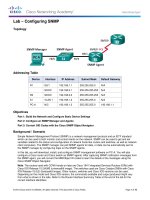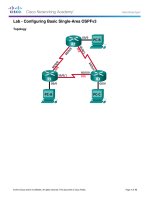CONTENTS MOLD WF3 kho tài liệu bách khoa
Bạn đang xem bản rút gọn của tài liệu. Xem và tải ngay bản đầy đủ của tài liệu tại đây (1.33 MB, 24 trang )
Pro/MOLDESIGN
Pro/MOLDESIGN tutorials have been developed with great
emphasis on the practical application of the software to
solve real world problems. The self-study course starts from
the very basic concepts and teaches advanced techniques
step by step. After completing these tutorials an Engineer or
Designer will be able to create the advanced parting
geometry, split the mold into Core and Cavity halves, create
Sliders and Lifters, define multi-cavity molds, create
runners, gates, sprue, cold slugs, create cooling channel
and check their clearance from neighboring surfaces.
The training material is divided into sections. Each section
is accompanied with exercises to practice the concepts
learned.
1. Introduction
2. Parting Surfaces
a. Manual Parting Surfaces
b. Automatic Parting Surfaces
3. Sliders and Lifters
4. Multi-Cavity Molds
5. Feed System and Molding
6. Water Line and Ejector Pins
7. Mold Analysis
8. Mold Layout And EMX
Prerequisites
The user should have basic concepts in the following
1) Solid Modeling
2) Surface Modeling
3) Assembly
Stats
Following are the stats for WF 3.0
Total Pages: 723
Total Exercises: 38
INTRODUCTION
The Introduction section elaborates the
following concepts.
Manufacturing model
Reference model
Shrinkage
Automatic workpiece
Concept of Accuracy in Pro/MOLD
Analyzing a part for its moldability
Concept of Parting Surface
How a split works
Creating mold components
EXERCISE 1
In this exercise user will practice the
following
Creating a new manufacturing model
Assembling the reference model
Analyzing the part with Draft Check
tool for its moldability
Analyzing the part for uniform
thickness using Thickness Check tool
Adding shrinkage to reference model
Creating the Automatic workpiece
Defining the style state for workpiece
Creating the Flat parting surface.
Splitting the workpiece into two
volumes
Extracting components out of split
volumes
Creating an Extruded parting surface
Splitting a volume to One Volume
Splitting a volume to Two Volumes
Reference Part
Creating a Multi-Insert Core
Analyzing with Draft Check Tool
Analyzing with Thickness Check Tool
EXERCISE 2
In this exercise user will practice the
following
Retrieving a mold model
Redefining the Workpiece
Modifying a parting surface
PARTING SURFACES
In this section we will learn in detail how
to build parting surfaces for simple and
complex parts using manual and
automatic techniques.
Manual Parting Surfaces
In this sub-section we will learn how to
build the parting surfaces using manual
surfacing techniques i.e. Extrude,
Revolve, Surface Copy, Advanced
Variable Section Sweep, Flat, Offset and
Free Form surfaces.
EXERCISE 1
In this exercise user will practice the
following
Creating a parting surface by using
Extrude tool
Creating a parting surface by using
Flat tool
Splitting the workpiece into two
volumes using multiple parting
surfaces
Reference Part
Core
EXERCISE 2
In this exercise user will practice the
following
Creating a parting surface by using
Revolve tool
Reference Part
Cavity
EXERCISE 3
In this exercise user will practice the
following
Creating the parting surface using
Copy Surface and Variable Section
Sweep technique
Splitting the workpiece into two
volumes using multiple parting
surfaces.
Extracting components out of split
volumes
EXERCISE 4
In this exercise user will practice the
following
Analyzing the part with Draft Check
tool to determine the suitable location
of parting surface
Filling the loops in a Copy surface
Creating an Offset parting surface
Creating the parting surface using
Free Form technique
Trimming a surface using edges of
the reference part
Merging the surfaces
Splitting the workpiece into two
volumes using multiple parting
surfaces.
Parting Surface and Reference Part
Core Half with Reference Part
Cavity
EXERCISE 5
In this exercise user will practice the
following
How to fill a cut that cannot be filled
with regular Pro/MOLD tools
Reference Part
Cavity
EXERCISE 6
In this exercise user will practice the
following
Creating a revolved surface
Creating parting surface interlocks
Creating stripper ring for ejecting
the part off the Core
Reference Part
Core Insert with Stripper Ring
Moving Half: Core Insert, Stripper Ring and
Base Plate
Cavity Plate with Interlocks
Complete Mold
EXERCISE 7
In this exercise user will practice the
following
How to create the local insert
How to split a mold that requires a
local insert
Reference Part
Cavity and Insert
EXERCISE 8
In this exercise user will practice the
following
How to reference pattern a parting
surface
Reference Part
Core
EXERCISE 9
In this exercise user will practice the
following
Creating a round workpiece
Trimming a surface to desired size
Transforming a surface
Creating variable section sweep
surfaces
Merging the surfaces
Patterning a parting surface
Axial Fan
Parting Surface for a single wing
Core Half
Parting Surface and Reference Part
Automatic Parting Surfaces
In this section we will learn how to build
the parting surfaces using Silhouette
Curve and Skirt Surface techniques.
EXERCISE 1
Topics covered in this exercise are as
follows
Creating an Automatic Parting Line
using Silhouette Curve
Creating the Automatic Parting
Surface using Skirt feature
Reference Part
EXERCISE 2
Topics covered in this exercise are as
follows
Creating an Automatic Parting Line
using Silhouette Curve
Creating the Automatic Parting
Surface using Skirt feature
Selecting the required loop for nondrafted walls
Reference Part
Design 1
Design 2
Handling Non-Drafted Walls
EXERCISE 3
Topics covered in this exercise are as
follows
How the Direction of Silhouette Curve
affects the resultant curve
Reference Part
EXERCISE 4
Topics covered in this exercise are as
follows
Creating an Automatic Parting Line
using Silhouette Curve
Creating the Automatic Parting
Surface using Skirt feature
Customized filling of inner loops using
Loop Closure option
Reference Part
Design 1
Design 2
Design 3
EXERCISE 5
Topics covered in this exercise are as
follows
Creating a slider for undercut condition
Handling undercuts during Silhouette
curve definition
Using the Shutoff functionality of skirt
surface to create parting surface
interlocks
Stripper Plate with Interlock -- Design 1
Stripper Plate with Interlock -- Design 2
Skirt Surface: Different Shutoffs
EXERCISE 6
Topics covered in this exercise are as
follows
How to control the tangency of the skirt
surface with reference part surfaces
Parting surface without Tangency conditions
Parting surface with Tangency conditions
EXERCISE 7
Topics covered in this exercise are as
follows
Creating an Automatic Parting Line
using Silhouette Curve
Creating the Automatic Parting
Surface using Skirt feature
Using the Extension Control dialog box
to exclude the unwanted segments of
the selected curve from extension
process.
Using the Extension Control dialog box
to change the default direction of
extension for skirt surface
Creating a lifter to form the undercut in
reference part
Reference Part
Core with Lifter
Lifter
EXERCISE 8
Topics covered in this exercise are as
follows
Adding a flange to the Automatic
workpiece
Creating an Automatic Parting Line
using Silhouette Curve
Excluding the unwanted Loops of
Silhouette Curve
Creating the Skirt surface for only
the selected segments of
silhouette curve
Defining multiple skirt surface
features within single parting
surface
Creating sliders
Reference Part
Core with Sliders
Slider
SLIDERS AND LIFTERS
Sliders and lifters are an essential part of the
mold assembly as they allow to form the
undercuts in the product. In the following
exercises we will learn different techniques
to create the sliders and lifters with least
effort.
EXERCISE 1
Topics covered in this exercise are as
follows
Creating a slider for an undercut
Reference Part
Cavity and Slider
EXERCISE 2
Topics covered in this exercise are as
follows
Creating a Slider for the openings in
the side wall of the reference part.
Reference Part
Cavity and Slider
EXERCISE 3
Topics covered in this exercise are as
follows
Creating a Lifter for the openings in
the side wall of the reference part.
Reference Part
Lifter and Core
EXERCISE 4
Topics covered in this exercise are as
follows
Creating a Slider for a cantilever snap
How to reference pattern a volume.
Reference Part
Core and Sliders
EXERCISE 5
Topics covered in this exercise are as
follows
Creating a Slider by Gather
technique.
Reference Part
Cavity and Slider
EXERCISE 6
Topics covered in this exercise are as
follows
Creating a Slider by Gathering and
Sketching technique
Reference Part
Cavity and Slider
EXERCISE 7
Topics covered in this exercise are as
follows
Creating a Slider by Gather and
Offset technique
Reference Part
Core and Sliders
MULTI-CAVITY MOLDS
In this section we will learn how to create
pattern of reference parts for multi-cavity
molds using the Layout dialog box.
EXERCISE 1
Topics covered in this exercise are as
follows
Assembling the reference model
using Layout dialog box
Creating the pattern of reference part
Creating parting surface for the
patterned parts
Patterned Reference Part
EXERCISE 2
Topics covered in this exercise are as
follows
How to control the orientation of
reference parts.
Patterned Part with Parting Surface
EXERCISE 3
Topics covered in this exercise are as
follows
How to create Automatic parting
surface for multicavity mold.
Patterned Reference Part
Cavity
EXERCISE 4
Topics covered in this exercise are as
follows
How to pattern a volume and parting
surface.
Patterned Reference Part
Moving Half : Back Plate, Stripper Plate, Core Inserts
EXERCISE 5
Topics covered in this exercise are as
follows
•
How to create Automatic parting
surface for a multi-cavity mold model
with different reference parts
Reference Parts (Both are different)
Reference Parts with Parting surface
FEED SYSTEM AND MOLDING
The feed system for a mold provides the path for
the molten material to flow from the nozzle of the
machine to the machined impression. This flowway is called the Feed System.
EXERCISE 1
Topics covered in this exercise are as follows
Creating the runner system by defining a
Runner feature
Creating the gates by defining a Runner
feature
Creating the sprue by defining a revolved cut
feature
Creating the molding for the cavity assembly
Creating the submarine gate
Molding Component
Pin-Pointed Submarine Gate
Truncated-Cone Submarine Gate
EXERCISE 2
Topics covered in this exercise are as follows
Creating the flow path for non-planar runner
Controlling the size of the branch runners
Creating the runner and gates by defining
Runner feature
Creating the sprue and cold slug by defining
a revolved feature
Creating the molding for the mold assembly
Multi-Cavity Molding with Sprue, Cold Slug, Runners and Gates
EXERCISE 3
Topics covered in this exercise are as follows
Creating the runner system by defining a
Runner feature
Creating the gates by defining a Runner
feature
Creating the sprue by defining a revolved cut
feature
Creating the molding for the cavity assembly
Feed System for a Long Slender Product
EXERCISE 4
Topics covered in this exercise are as follows
Creating the Pin-point gates
Creating the Round Trapezoid runner
Creating the molding for the cavity assembly
Calculating the weight of feed system
Pin-Point Gate and Round Trapezoid Runner for Three Plate Mold
WATER LINE AND EJECTOR PINS
Waterline feature is used to create cooling channel in
the mold components.
Ejector Pin Catalogue is used to assemble the ejector
pins in the manufacturing assembly.
EXERCISE 1
Topics covered in this exercise are as follows
Creating the Water Line feature
Specifying End Condition for the channel.
Cooling Channels with Counter-bored Ends
MOLD ANALYSIS
Pro/MOLDESIGN provides a number of tools to ensure
that mold cavity will perform satisfactorily during actual
production. These tools verify that mold confirms to
some minimum criteria set by the mold designer. These
include
Water Line clearance check
Mold opening analysis
Parting surface check
Projected area calculation
EXERCISE 1
In this exercise we will check the clearance between the
waterlines and the surrounding surfaces of selected
component.
Topics covered in this exercise are as follows
Checking the clearance for the given waterline
EXERCISE 2
The topics covered in this exercise are as follows
Defining mold opening sequence
Checking interference during mold opening
simulation
Mold Opening Simulation
MOLD LAYOUT AND EMX
In this section we will discuss the Mold Layout
functionality. We will also describe the benefits EMX
(Expert Moldbase Extension) over Mold Layout.
